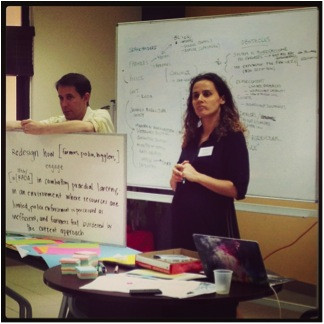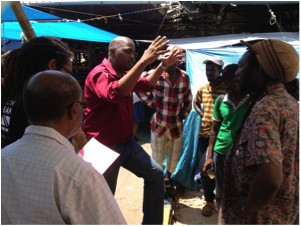A significant portion of the World Bank’s portfolio is dedicated to helping client country governments more effectively deliver basic public services to citizens in challenging environments. In a recent post, World Bank President Jim Yong Kim noted a need for a science of service delivery, because “we still lack a framework for systematically understanding what does work in a given time or place, and holding officials accountable to that standard.” As each of us knows from our daily lives, the most effective services are ones that fit within our constraints, make complicated tasks easier, and help us reach mission-critical goals in our jobs and personal lives. How can governments and their development partners design services that alleviate poverty while meeting our own high standards as users?
Design thinking is a methodology that can unpack the underlying assumptions that often go unchallenged and unverified during the service preparation and implementation process. The Governance Collaboratory (Collab) at Stanford—a joint collaboration of the Center for Democracy, Development and the Rule of Law (CDDRL), and the d.school—is exploring how civil society activists and service providers can use the design thinking approach to solve governance bottlenecks that prevent them from achieving their goals.
 Professor Jeremy Weinstein and Jenny Stefanotti of Stanford’s d.school. (Photo by Joshua Goldstein)
Professor Jeremy Weinstein and Jenny Stefanotti of Stanford’s d.school. (Photo by Joshua Goldstein)
In March, I traveled with the Collab to Kingston, where together with the Jamaican Ministry of Agriculture’s Rural Agriculture Development Agency (RADA), the Mona School of Business, and Slashroots, a Caribbean civic technology group, it was testing its model on a pervasive challenge facing Jamaica’s agriculture sector. Praedial larceny, the theft of agricultural produce or livestock, is a significant challenge for smallholder farmers. In a particularly devastating incident, 42 cattle were stolen on the night before Christmas, virtually shutting down a farm that employed 22 people.
The three-day praedial larceny design challenge, almost physical in its intensity, had five components that draw the service designer closer to the user: empathy-define-ideate-prototype-test. My team for the challenge, which included a staffer from the President’s Cabinet Office, a senior member of the Rural Agriculture Development Agency (RADA), and a technologist from Slashroots, spent a significant portion of the first day talking with individual higglers (market hawkers who are often also small scale farmers) and RADA extension workers to learn about how each of these groups cope with praedial larceny and minimize the effects in their daily lives. In the course of our conversation, we learned something surprising: Farmers typically know the people who rob them and feel that they will be punished socially if they report crimes to the police.
 Stotrell Craig Lowe from Jamaica’s Office of the Cabinet, empathizing, big-time, at Coronation Market in Kingston. (Photo by Jenny Stefanotti)
Stotrell Craig Lowe from Jamaica’s Office of the Cabinet, empathizing, big-time, at Coronation Market in Kingston. (Photo by Jenny Stefanotti)
Are you enjoying this article? Read more like this, plus SSIR's full archive of content, when you subscribe.
Two important differences between design thinking and the more traditional public service project preparation emerged from these conversations. First, design thinking challenges what journalist provocateur Evgeny Morozov calls “solutionism”—the tendency to believe that we can solve deep-seated societal problems through technological innovation. The distinction is not that users are not consulted in the traditional process, but rather that their consultation is too superficial, often tied to a menu of predetermined options. For example, residents in an urban community slated for urban upgrade might be asked to list their priorities in a community meeting, but such group settings make it difficult to reveal unspoken insights about the underlying constraints and social pressures that shape daily life.
The design thinking process, on the other hand, seeks to propagate system changes around specifically defined users. After an hour of generating ideas about user attributes, needs, and insights, we decided to define our user as a poor, female higgler who has 20 years of experience and needs to minimize the effect of praedial larceny while maintaining social acceptance.
Our insight was that the stigma attached to theft is much less than the stigma attached to being an informant. Insights revealed by design thinking complement insights revealed by other social science tools. Surveys can tell us about the rate of praedial larceny and the characteristics of the mean farmer; evaluations can give a post-hoc sense of whether an intervention worked. However, these tools do not reveal the behavioral insights up front that can mean the difference between success and failure.
Second, the design thinking process can vastly expand the solutions space to governance challenges. The problem is typically not that policy makers believe that they have all the answers (at least most of the time), but rather that they lack the tool set for generating actionable insights from actual end users. The ideate component is about flaring out: putting on paper as many ideas as possible about how to serve the specific user we have defined. This brainstorming effort is bounded around a specific “How might we … ?” question; our group focused on how we might make protecting one another’s property more attractive to higglers.
An important part of expanding the solutions space is getting feedback from users early and often. During the afternoon session on the second day, we were already into the prototype component, designing low-resolution physical representations of some of our most promising ideas to garner constructive criticism from users. At this point, our group was exploring the idea of a farmer’s collective fund that paid dividends when the community prevented praedial larceny for an entire year. Since we didn’t know whether farmers would be more interested in the social message of protecting their neighbors or the financial message of earning dividends, our prototype was a role-playing game, where we would present an advertisement with the two messages and then ask a farmer to choose one to invest in.
Consider the difference between this approach and the way RADA designed its receipt book, a tracking system designed to be a comprehensive database of agriculture transactions. It was designed using an inclusive process, and a committee of farmers signed off on every step, from the idea of receipts to the way the booklets looked and felt. What did not happen, however, was testing a receipt-book mockup with actual users, getting feedback, and re-imagining the process based on these lessons. The World Bank, where projects often face a rigorous two-year project preparation timeline, presents scant opportunity to empathize with end users.
After the market, we closed out the workshop by reflecting on the process. A RADA official wanted to explore how lessons from the workshop could help him design better farmer databases. A police officer suggested that higher-level political officials should take part in these workshops. A member of Slashroots said he wanted to lead trainings like this for other Jamaicans. For me, the lesson from the design challenge is that the science of service delivery is at least in part a design science. The challenge now is exploring how public sector, often risk-averse organizations can use design to solve complex governance bottlenecks, and how we can develop a better understanding about the types of problems that design thinking can help us solve.
Support SSIR’s coverage of cross-sector solutions to global challenges.
Help us further the reach of innovative ideas. Donate today.
Read more stories by Joshua Goldstein.

